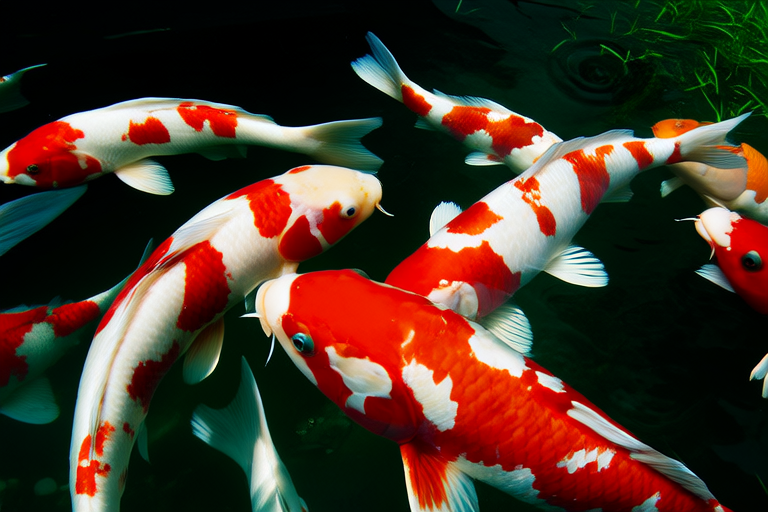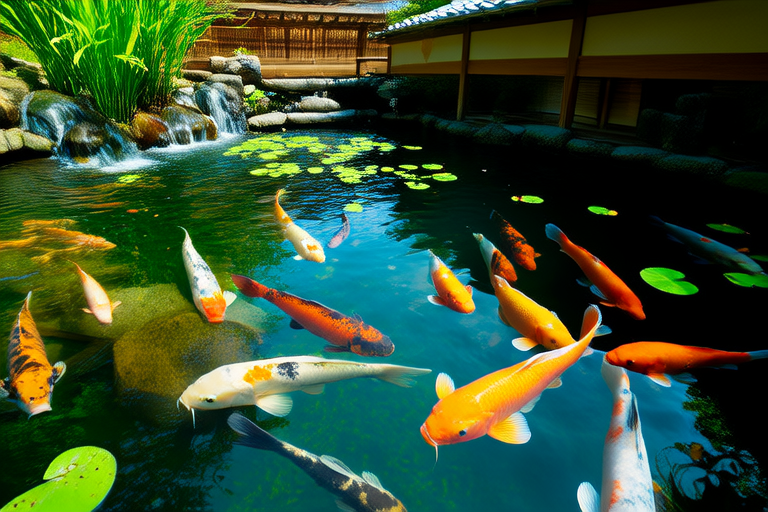
Exploring Koi Behavior: Social Structures, Communication, and Environmental Interactions
Koi, scientifically known as Cyprinus carpio, are ornamental varieties of common carp that have been selectively bred for their vibrant colors and patterns. These fish are not only admired for their aesthetic beauty but also for their complex behaviors and intelligence. Understanding koi behavior involves exploring their social structures, communication methods, and environmental interactions. This article delves into how koi express emotions, recognize individual owners, and react to different stimuli within their aquatic environment. Additionally, it discusses koi schooling patterns, feeding behaviors, and their ability to learn and remember tasks. Insights into how water conditions and pond landscapes influence their activity levels and interactions are provided, along with tips for pond owners to better understand and engage with their koi.
Social Structures and Communication Methods
Koi exhibit a hierarchical social structure within their community. Dominance is established through aggressive displays, such as chasing, biting, and fin nipping. The most dominant koi often have priority access to food and prime territories. However, this hierarchy is fluid and can change based on various factors, including size, age, and health status. Subordinate koi may show signs of submission by swimming away or avoiding confrontations with more dominant individuals.
Communication among koi is primarily non-verbal and involves visual, tactile, and chemical signals. Visual cues include body posture, color changes, and tail movements. Tactile communication occurs during physical interactions, such as rubbing against each other or engaging in mutual grooming. Chemical signals, or pheromones, play a crucial role in regulating social behaviors, reproduction, and stress responses. For example, injured koi release alarm pheromones that alert nearby individuals to potential threats.
Emotional Expression and Recognition of Owners
While koi do not display emotions in the same way humans do, they can exhibit behaviors that suggest emotional states. For instance, koi may become agitated or stressed when exposed to loud noises, sudden movements, or poor water quality. Conversely, they may appear calm and relaxed in stable environments with appropriate water parameters and sufficient hiding spots. Some koi enthusiasts believe that koi can form bonds with their owners and recognize them over time. This belief is supported by observations of koi approaching the edge of the pond in anticipation of feeding times or following owners around the pond.
Reaction to Different Stimuli
Koi are highly sensitive to changes in their environment and respond accordingly. They are particularly attuned to variations in water temperature, pH levels, and oxygen concentration. When these parameters fall outside their optimal range, koi may become lethargic, lose their appetite, or exhibit abnormal swimming patterns. In contrast, koi thrive in well-maintained ponds with stable water conditions and adequate filtration systems.
Different stimuli elicit distinct reactions from koi. For example, koi may swim rapidly away from perceived threats, such as predators or unfamiliar objects, while they approach food sources eagerly. Some koi have been trained to perform tricks, such as jumping out of the water or retrieving objects, demonstrating their capacity for learning and adaptation.
Schooling Patterns and Feeding Behaviors
Koi typically school together for protection and social interaction. Schools can consist of two or more individuals, depending on the size of the pond and the number of koi present. While koi do not always maintain strict formations like some schooling fish, they tend to stay close to one another and move in unison when threatened. Schooling behavior provides benefits such as increased vigilance against predators and improved foraging efficiency.
Feeding behaviors vary depending on the type of food available and the individual preferences of each koi. Some koi prefer floating pellets, while others may favor sinking pellets or live foods like worms and insects. Koi can be trained to accept hand-fed treats, which can strengthen the bond between fish and owner. It’s important to note that overfeeding can lead to poor water quality and health issues, so it’s essential to monitor feeding amounts carefully.
Learning and Memory
Koi possess remarkable learning abilities and can remember tasks for extended periods. For instance, koi can be trained to ring a bell by pressing a lever or swim through hoops. These feats demonstrate their capacity for associative learning and problem-solving skills. Additionally, koi have been observed returning to specific locations within their pond at regular intervals, suggesting an understanding of spatial relationships.
Influence of Water Conditions and Pond Landscapes
Water conditions significantly impact koi behavior and overall health. Optimal water parameters include a pH level between 7.0 and 8.5, ammonia and nitrite concentrations below detectable limits, and dissolved oxygen levels above 6 parts per million (ppm). Maintaining these conditions ensures that koi remain active, healthy, and responsive to their surroundings.
Pond landscapes also play a vital role in shaping koi behavior. Shelters, such as caves, plants, and rocks, provide hiding spots where koi can retreat when feeling threatened or resting. A diverse and well-planned pond landscape encourages exploration and social interaction among koi. Additionally, incorporating features like waterfalls and streams can enhance water circulation and oxygenation, promoting better overall water quality.
Tips for Pond Owners
To foster a healthier and more harmonious relationship between koi and their caretakers, pond owners should prioritize regular maintenance and monitoring of water conditions. This includes testing water parameters regularly, performing partial water changes as needed, and ensuring proper filtration and aeration systems are in place. Providing a balanced diet and training koi to accept hand-fed treats can also strengthen the bond between fish and owner.
Pond owners should also consider the social dynamics of their koi community and take steps to promote positive interactions. This may involve introducing new koi gradually to allow for acclimation and minimizing aggression. Creating a diverse and stimulating pond environment can encourage exploration and socialization among koi, leading to a more enriched and enjoyable experience for both fish and owner.




